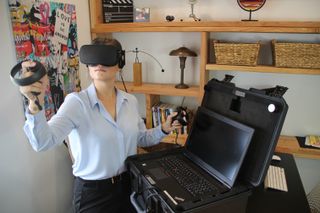WorldViz Vizible Now Available, VizBox Presentation Hardware Revealed

WorldViz today announced that its multi-user virtual reality presentation software is now available to all businesses. The company also revealed the VizBox, an all-in-one, portable VR presentation system for off-site demonstrations.
Last summer at SIGGRAPH, WorldViz revealed Vizible, a collaborative, multi-user VR presentation platform for enterprise level businesses that enables collaboration between remote colleagues around the world. The company also billed Vizible as a powerful tool that would enable sales teams to demonstrate massive items, such as airplanes or building designs, to potential customers.
When WorldViz revealed Vizible, the company said that the software would be available in October 2017. However, software development doesn’t always go as planned, and the company ultimately delayed the release by a couple of months. WorldViz released Vizible in January, but you had to have an existing business relationship with WorldViz to get access to it. Today, Vizible is available for any company that’s interested.
We had a chance to see Vizible in action ahead of WorldViz’s announcement. The company’s CEO and co-founder, Andrew Beall, gave us a personal demonstration of the tool, and we have to say, we like what we saw. Vizible is WorldViz’s vision for a presentation system in VR, and what the company created is quite powerful indeed.
Beall described Vizible as a combination of PowerPoint and Skype, mixed into a virtual environment. We would also add GoToMeeting to that description, because presenters can send a link for guests to click and jump right into a virtual session. Aside from waiting for a sizable download (over 400MB for the client, plus textures and models for each new session), it’s relatively simple to hop into a meeting.
Vizible supports multiple headset options. Currently, Vizible works with Oculus Rift and HTC Vive headsets, and you can access Vizible presentations with a desktop PC. The software doesn’t yet officially support Windows MR, but Beall said that feature is coming and that his team is already getting spoiled by the Samsung Odyssey’s higher-resolution displays.

Beall explained that Vizible presentations could be anything you want them to be. The software supports standard file formats, such as PDFs, image files, and videos. You can even bring in existing slides from PowerPoint, which enables you to port existing presentations into virtual presentations. Images, slides, and videos can be presented on a single virtual projection screen, or you can use multiple copies of the same image to give everyone a close-up vantage. Beall even showed us a wrap-around video array, which featured many different video clips that he could queue up one at a time, or all at once.
Stay on the Cutting Edge
Join the experts who read Tom's Hardware for the inside track on enthusiast PC tech news — and have for over 25 years. We'll send breaking news and in-depth reviews of CPUs, GPUs, AI, maker hardware and more straight to your inbox.
Vizible also allows you to bring interactive 3D models into the presentation space. The software supports standard polygonal 3D models from most CAD applications. Beall showed us a few examples, such as a full-scale Boeing 747 with an animated breakdown of a turbine engine. He also showed us several highly detailed, to-scale 3D models of cordless drills, which gave us an example how well Vizible would work for sales teams, or for global corporations to bring their departments together for meetings without flying people around the world.
Portable VizBox Kiosk
Beall even showed us a virtual demonstration of his company’s own hardware product. The executive switched the environment and brought us into a small virtual room with a table in the center. On the table, lay a 3D representation of the VizBox, a large Pelican hard case with a VR presentation kiosk built-in.

The VizBox is an all-in-one presentation system that WorldViz created for its clients. It features a Lenovo gaming laptop with a Nvidia graphics card that slots into a water-jet formed foam tray, which includes gaps for air flow, and channels to route cables. Beall said that his team research foam materials to find one that would protect the hardware and enable the company to leave all the cables plugged into the laptop. Below the laptop tray, there is a storage compartment for an Oculus Rift headset and two Touch controllers. The case even comes with the sensors pre-installed in the lid, so all you have to do is put the VizBox on a table, open the case, pull out the headset, lift the screen for the laptop, and turn it on. The laptop power adapter is the only cable you have to plug in, but WorldViz is exploring the idea of installing a lithium-ion battery pack, to facilitate remote setups.
Beall said the VizBox is durable enough to send on an airplane or ship via courier . You could send the VizBox to clients to give them a portal to visualize large-scale projects and stay up to date. It’s also a great solution for tradeshow setups because it’s so portable and easy to set up.
“Current methods for visualizing complex information such as product designs or architectural designs, are falling short. Businesses are using blueprints and 2D screens to try to extrapolate what a 3D design might look like at scale, and that just doesn’t cut it, especially when the smallest mistake can cost a company millions of dollars,” said Beall in a press release. “VR provides a better way to communicate that information, and a better means for collaborating around that information, which is why we designed Vizible and its companion product, VizBox.”
Available Now
WorldViz’s Vizible platform is available on a subscription basis. The starting price is $250 per use per month, which enables one person in your company to create and host presentations. Anyone can join a presentation at no cost.
VizBoxes aren’t yet available, but WorldViz said the portable VR kiosks would be available in May. The kits aren’t cheap at $7,900, but these aren’t meant for consumer use. The VizBox is a business-to-business product for the enterprise market. The type of companies that WorldViz built the VizBox for are accustomed to paying big dollars to attract clientele.
Kevin Carbotte is a contributing writer for Tom's Hardware who primarily covers VR and AR hardware. He has been writing for us for more than four years.
-
bit_user There is something cinematic about the a briefcase getting delivered and you open it up, turn it on, and strap on the HMD. Or some suits show up with said briefcases, open them up, and instruct you to don the HMD.Reply
However, I think Hololens and Magic Leap will be much more friendly for business presentations.
For true VR, Windows MR HMDs would be a more economical option than building this around Rift or Vive.
Most Popular



